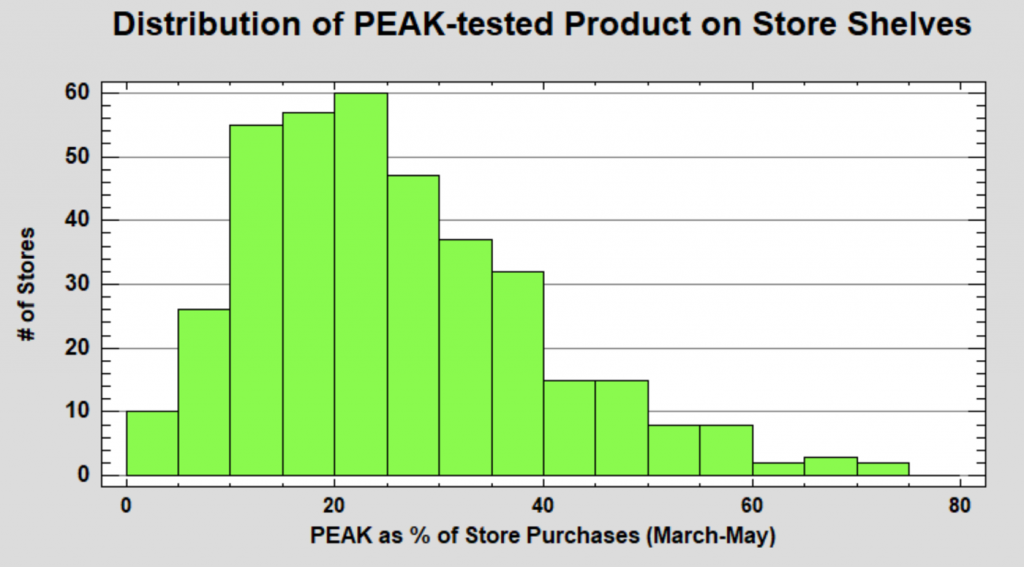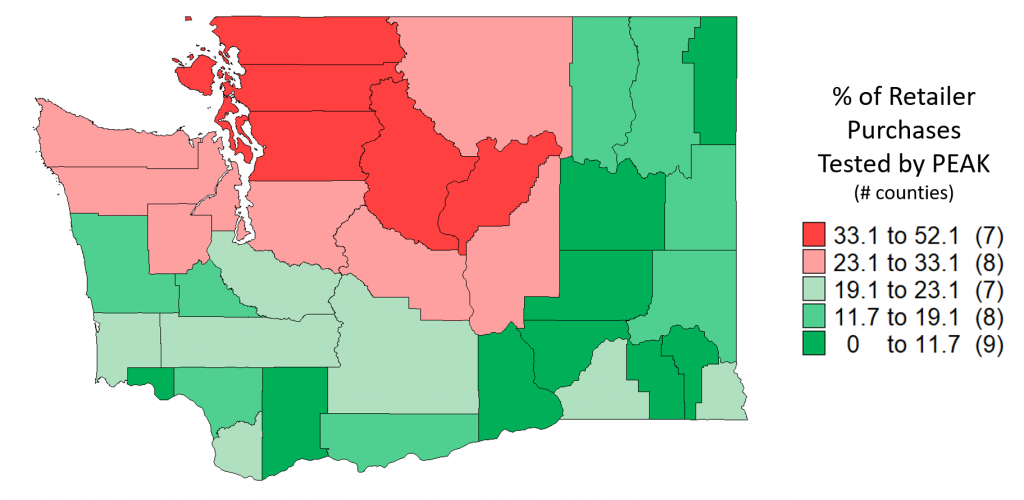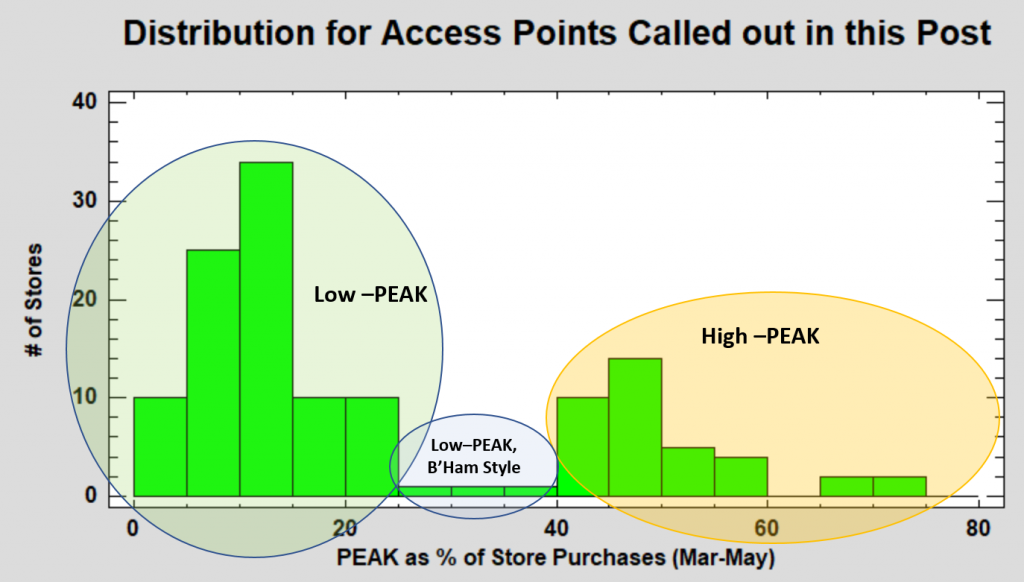“An ignorant consumer is a marketer’s dream”
The continued availability of PEAK-tested product to those Washington consumers wishing to acquire their Cannabis from State-legal access points is not an emergency, in my mind. Apparently it is also not an emergency in the collective minds of the LCB and the office of our Governor.
I am, however, absolutely sure that it is an issue worthy of not only official oversight, but of consumer awareness. It is an issue of concern and it is an issue worth consideration.
This post is in the spirit of promoting targeted, efficient, consumer awareness. It is in the spirit of consumer safety.
PEAK Analytics’ certification that enabled them to test State-legal Cannabis in Washington was recently suspended. Read Bob Young’s article in the Seattle Times from last week, or some stuff I posted on HI-Blog for details.
To cut to the chase, I am of the absolutely firm belief that product on the market today that has been tested by PEAK is, statistically, causing harm to people consuming it. That does not mean it is causing harm to every user. That does not mean it has caused harm to ANY user, thusfar.
I don’t know enough about the morbidity or mortality underlying exposures to “total coliforms” and/or “enterobacteriaceae” to make such judgments in a precise fashion. What I DO know is that hundreds of thousands or millions of potentially harmful exposures have a POTENTIAL to cause harm. It’s all about incidence, at that point (which is something I currently know little about).
What I DO know something about (thanks to much of my time over the past two days) is how many people have likely purchased PEAK product since PEAK’s certification was suspended. Further, I have a pretty good idea of how many of those people were (per the data in both the auditor’s report and in the State’s traceability database) likely exposed to one or both of the nasty bugs that PEAK apparently sucked at detecting. My current model estimates that around 550 people are purchasing PEAK-tested product every day (on average … more on Fridays, fewer on Sundays) that would be expected to contain “bad bugs” at levels that would have failed QA testing (on average) if they had been tested by any other lab operating in the industry. We are approaching 10,000 such exposures in Washington thusfar (out of the approximately 950,000 consumers that have likely purchased PEAK-tested product since PEAK’s certification was suspended).
I am convinced there is (statistical) risk in consuming PEAK-tested product. Risk today. Risk now.
No doubt, MUCH of the product tested by PEAK is likely just fine with respect to “Quality Assurance” status. (I’d argue that PEAK likely over-states the cannabinoids of the product, but that is for another time and is not consistent with what the LCB’s auditor concluded).
Regardless, follow the argument in the sources cited above to make your own judgements.
If you think there might be reason to worry about whether or not product you are about to buy was tested by PEAK, please read on.
Many of the stores in this state (based on personal observation and lots of input I’ve received) are not able to readily produce the COAs (Certificates of Analysis) produced by the labs that tested the product in their shelves. If someone supplies one to you, check to see that the product lot number corresponds to the product you are considering.
Given that common inability on the part of Retailers, you should always ask who tested product. If the store can tell you, then decide accordingly (read Bob’s article and my previous posts, first though). If the store can’t tell you, then do what you wish, but I’d advise you to take your hard-earned cash (or bitcoin) and go to another store.
Your choice again.
For those of you that just can’t bring yourselves to ask who tested the purchase you’d like to make or who are not willing to endure the frequent delays and bullshit that such requests tend to evoke, the rest of this post should help you minimize the likelihood that the product you are buying “blind” was tested by PEAK. If you care about that, read on. If not, then don’t.
I will try to minimize my words from this point on … and focus you on 3 charts and one big table.
*******************************************
This post is about where you are more (or less) likely to come across PEAK-tested product currently on the shelves of Washington’s State-legal Cannabis stores, should you find yourself inside one of those adults-only establishments.
Earlier this week, I sent a detailed note out to most of the active Retail Access Points in the State that I will paraphrase using the words of a friend and mentor (who is advising me on my communication style and who suggested the following mature, professional and articulate summary of one of my lengthier passionate rants):
“Dear Retailer: my analysis of PEAK indicates that you may be sitting on tainted product. Let’s show our community values and voluntarily pull those products off the shelves.”
It is my sincere hope that at least some of them pull PEAK-tested product from their shelves. It is my even greater hope that the LCB will do this across the board. I am not, however, holding my breath.
This encapsulates the goal of the note I sent out to retailers. As the WSLCB does not seem to deem pulling PEAK-tested product from shelves to be consistent with their mission to protect and enhance public safety (and health), while I do, I thought I should help to inform others that are trying to evaluate whether or not they should care about this issue.
I firmly believe that reasoned adult consumers should be able to make better-informed decisions when the situation merits. Read on if you believe there to be an acute issue regarding human consumption of PEAK-tested product. Read on if you think the continued availability of PEAK-tested product on the shelves of Washington stores represents such a situation. If not, then don’t waste your time (other than marveling at my map-making and histogram-formatting skills).
PEAK-tested Product purchases by Retail Access Points between March and May, 2017
The county-level map below is based on purchases by Retailers between March and May of this year
County-Level Averages:
PEAK Analytics’ recently-shuttered facility is located in Bellingham, up near the upper left corner of the red mass above. I live in that red mass. I’m not happy about that.
What this shows is a geographic bias toward PEAK-tested product representing a larger portion of the product on Retailer’s shelves the closer one gets to Bellingham. That makes sense in that local farmers would tend to use the only lab (I believe) that is up there. Local farmers would also, presumably, prefer to drive 10 miles to deliver product, rather than 200. That, no doubt, tends to drive the red up in the northwest.
Note, though, that PEAK-tested product is, virtually, everywhere.
If you are shopping anywhere without asking/knowing who tested the product you purchase, you are more likely to get PEAK-tested in the Red counties than in the Green ones. I hope that helps.
Listing of Stores that are, locally, relatively PEAK-heavy or PEAK-light:
On a more intimate level, not all stores purchase PEAK equally. The following is a list of the stores that, relative to local norms, display either a higher or lower percentage of PEAK-tested product on their shelves. I will not burden you with the rules underlying my categorization into HIGH and LOW PEAK-tested Retail Access Points, but I will mention that I treated Whatcom county (Bellingham’s home county) differently because almost all of their stores bought lots of product from wholesalers that test with PEAK. Given how that shifted their distribution (dramatically), a different set of cutoffs seemed in order for that county.
Before I list the stores, a quick summary:
394 stores bought product from wholesalers during the current quarter (March-May, 2017)
I removed 17 stores from the analysis, as they had purchased less than $10,000 of product during that time. Their data were too thin to be categorized with any confidence (the GOOD kind of confidence, that is).
The remaining 377 stores were categorized into 3 groups:
-Locally High-percentage of PEAK (“Bad”)
-Locally Low-percentage of PEAK (“Good”)
-Locally everyone else (“Meh”)
When I was all done, there were 38 “Bad” stores (10.1% of all stores) and 91 “Good” stores (24.1% of all stores). The other 248 “Meh” stores all carried PEAK, but at levels close enough to the average for their County that I did not believe they merited a specific call-out. The table listing stores at the bottom of this post lists only the “Good” and “Bad” locations (with respect to the likelihood of a non-COA-informed purchase in them resulting in PEAK-tested product).
Distribution of the number of stores by the Percent of PEAK-tested product they carry:

Lots of variability in there. Variability is good (it’s the statistical equivalent of diversity, after all).
Here is the Distribution of PEAK-tested percentages for the Stores that I have included in the list below:
The LOW and HIGH groups are fairly clear. Please note that the low plateau in the middle of the chart reflects that fact that I chose to place a higher threshold of “Good” for stores in Whatcom county, so that interested consumers up there would still be able to play the odds a bit better in choosing which stores they choose to frequent until such time as the LCB does something about this.
On average, the stores I am calling “LOW PEAK-tested” had about 11.3% (on a dollar basis) of the product they purchased tested by PEAK. The “HIGH” stores averaged 49.3% PEAK-tested purchases.
Here is a table listing of stores corresponding to the 2nd histogram above (It is one big graphic … I hope you can download and read it). I arranged it by county and city … then sorted alphabetically within city.
Green shaded-stores are less PEAK-heavy. Orange- shaded ones are more PEAK-heavy.
I hope you find this useful. Remember … lots of PEAK-tested product is, no doubt, just fine. Some of it is probably excellent (I know some farms and farmers that I trust, for example, that have used PEAK for their testing). Some of it is also likely product that should never have passed QA testing.
Whether that matters or not seems to be a matter of debate for some. It is not, however, in my simple mind.
Please share your comments and opinions on this blog post. I will try to respond reasonably quickly.
Be safe, be healthy, and hoping to see you at the 26th annual Hempfest next weekend. I’m on a panel discussing labs on Sunday afternoon. If I’m shopping before then, it is likely to be at either a green-shaded shop or at one that can provide me with the COA corresponding to the product I’m considering.
PLEASE ASK THE BUDTENDER TO SHOW YOU THE COA THE NEXT TIME YOU SHOP. If they can’t produce one — complain and walk.


